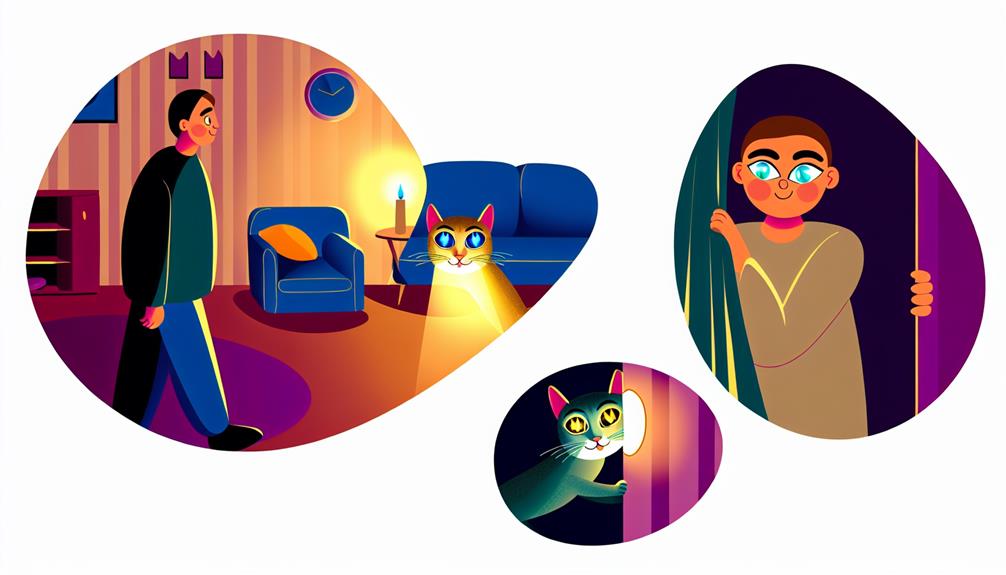Ever wondered why your cat seems to shadow your every move? It's not just a quirky habit; there's a mix of natural instincts and emotional connections at play. Cats are territorial by nature, and your presence offers them a sense of security and control over their environment. Plus, the bond you share fosters a strong sense of companionship, making them seek your attention and comfort. But there's more to it—curiosity and routine also drive this behavior. Stay with us as we uncover the fascinating reasons behind your feline friend's loyal following.
Natural Instincts
Cats are fascinating creatures, and their behaviors often stem from deep-rooted natural instincts. When you notice your cat following you around, it's not just because they enjoy your company—there's a lot more at play. Understanding these natural instincts can help you appreciate why your feline friend behaves this way.
Firstly, cats have a strong territorial nature. Your home is their domain, and they see you as part of that territory. By staying close, your cat guarantees that their environment is safe and under control. They might follow you from room to room to keep an eye on their territory, making sure there are no intruders or changes. This sense of security is deeply ingrained, stemming from their wild ancestors who had to protect their hunting grounds from rivals.
Speaking of hunting behavior, this instinct also plays an essential role. In the wild, cats follow their prey closely to learn their habits and strike at the right moment. While your cat might not need to hunt for food, the instinct remains. Following you allows them to engage in a form of this behavior, even if it's just a shadow of their wild hunting days. You might notice them pouncing on your feet or chasing after you playfully—these actions are all part of their innate hunting skills.
Social Bonding
When your cat follows you around, it's often a sign of seeking companionship and wanting to strengthen your relationship. Cats form strong emotional bonds with their owners, much like any other pet. By staying close to you, they feel secure and connected, reinforcing your mutual trust and affection.
Seeking Companionship
Many feline enthusiasts will agree that one of the most endearing aspects of a cat's behavior is its tendency to seek out its owner for companionship. Cats often engage in playful interaction with their humans, whether it's chasing a toy or pouncing on a string. This playful bonding is more than just fun; it's a form of social engagement that strengthens emotional support between you and your cat.
When your cat follows you around, it's demonstrating a behavioral pattern rooted in mutual trust and attachment. These moments of shared activities, like sitting together on the couch or following you into the kitchen, contribute to a deeper feline attachment. The companionship you provide offers your cat a sense of security and stress relief, which in turn has notable health benefits for both of you.
Understanding these patterns helps you recognize that your cat's behavior isn't random; it's a genuine expression of its desire for social bonding. The emotional support gained from these interactions enhances your cat's well-being and enriches your own, creating a harmonious living environment. So, next time your cat follows you, remember it's seeking more than just attention—it's seeking companionship.
Strengthening Relationship
A key element in strengthening the relationship between you and your feline friend lies in understanding the importance of social bonding. Building trust with your cat begins by recognizing their need for emotional connection and mutual understanding. Engaging in routine activities like feeding and grooming can reinforce positive interactions and deepen your bond.
Pay attention to your cat's communication cues. Responding to their meows, purrs, and body language shows you understand their needs and fosters trust building. Shared experiences, such as playtime engagement with toys or interactive games, are essential for behavioral reinforcement. These activities not only provide physical stimulation but also create a sense of companionship and affection display.
Incorporate moments of affection display into your daily routine. Gentle petting, brushing, or simply sitting together can enhance your emotional connection. Consistency in these actions helps establish a comforting routine, making your cat feel secure and loved.
Seeking Attention

Craving companionship, cats often follow their owners as a way to seek attention and interaction. This attention seeking behavior is a fundamental aspect of feline communication. When your cat trails behind you or sits beside you, it's their way of saying, "Hey, I need some love and playtime." Unlike dogs, whose attention-seeking can be more overt, cats have subtler ways of expressing their need for interaction, making it vital to recognize and respond to these cues.
Cats are social creatures who naturally crave stimulation and engagement. When they follow you around, it's not just about being physically close; they're also looking for emotional connection. This behavior can be a sign that your cat feels safe and trusts you deeply. They might rub against your legs, meow softly, or even purr—all signals in their intricate system of feline communication that indicate they desire your attention. Ignoring these signs can lead to a stressed or anxious cat, which is why understanding and responding to their needs is imperative.
Furthermore, cats often imitate the routines of their human companions as a form of bonding. Whether you're cooking, working, or merely lounging on the couch, they want to be part of your activities. This inclusion satisfies their need for social interaction and reinforces your role as a significant figure in their lives. So, the next time your cat shadows you from room to room, take a moment to engage with them. A little petting, playing, or simply talking to your feline friend can go a long way in addressing their attention-seeking behavior and fostering a healthier, happier relationship.
Curiosity and Exploration
Cats are naturally curious creatures, driven by their instincts to explore their environment. They need constant stimulation, and following you around can be part of their way to engage with the world. Additionally, this shared exploration can strengthen the bond between you and your feline friend.
Instincts and Natural Behavior
Ever wonder why your feline friend seems to be your constant shadow? It's rooted in your cat's instincts and natural behavior. Cats are curious creatures, driven by hunting instincts that make them keen observers. When they follow you, they might be engaging in a form of play behavior, mimicking the stalking and chasing they would do in the wild.
Additionally, territory marking is essential for cats. By following you, they can reinforce their scent trails, guaranteeing their territory is well-marked. This is especially important in maintaining their social hierarchy and communicating with other potential intruders. Their actions can also be part of a survival strategy, keeping close to their 'pack'—yes, even solitary hunters like cats have pack behavior tendencies.
Interestingly, some of their following behavior may stem from maternal instincts. In the wild, mother cats keep their kittens close for protection and teaching. Your cat may see you as a surrogate parent, needing to stay near for safety and guidance.
Cats also rely heavily on communication signals and have a high predator awareness, constantly evaluating their environment for any threats. Following you guarantees they're in the loop, ready to respond to any changes.
Environmental Stimulation Needed
While a cat's instincts and natural behaviors are primary reasons they follow you, their need for environmental stimulation also plays a significant role. Cats are naturally curious creatures that thrive on sensory enrichment and diverse play opportunities. Providing interactive toys can captivate their attention and keep them engaged. Introducing environmental variety through safe spaces and climbing structures allows them to explore and satisfy their innate climbing instincts.
Visual stimulation is essential for your feline friend. Positioning their favorite perch near a window lets them enjoy natural light and watch outdoor activities, which can be endlessly fascinating. Scent exploration, such as introducing new scents in their environment or using cat-safe plants, can also pique their interest and provide mental stimulation.
Auditory engagement is another important aspect of keeping your cat entertained. Soft music or nature sounds can be soothing, while interactive toys that make noise can spark their curiosity. Ensuring your home offers a range of sensory experiences will keep your cat mentally stimulated and reduce any anxiety or boredom they may feel.
Bonding Through Discovery
The magic of discovery often strengthens the bond between you and your feline companion. Cats are naturally curious creatures, and when you engage in playful exploration together, it creates shared adventures that foster deeper connection. These joint activities aren't just fun; they're essential for trust building and interactive learning. By participating in exploration games, you provide your cat with mental stimulation and physical exercise, which are key to a happy, healthy life.
Mutual discovery is a cornerstone of playful bonding. When your cat follows you, it's an opportunity for both of you to explore new environments and experiences. This shared curiosity can turn mundane moments into exciting exploration games, making everyday interactions more enriching. Whether it's a new toy, a hidden treat, or even a cardboard box, these activities encourage your cat to trust and rely on you as a partner in adventure.
Through these joint activities, you'll notice a significant improvement in your relationship. Engaging in mutual discovery not only satisfies your cat's curiosity but also makes you an integral part of their world. This harmonious blend of playful exploration and shared adventures ultimately enhances the bond you share.
Comfort and Security

When your cat follows you around the house, it's not just a quirky behavior—it's a demonstration of the comfort and security they feel in your presence. Cats are often seen as independent creatures, but they also crave emotional support and a safe space, much like humans do. Your consistent presence provides them with a sense of stability and reassurance.
Imagine your home from your cat's perspective. It's a world full of potential dangers and unknowns. Your presence transforms this environment into a safe space where they can relax and feel protected. When they follow you, it's their way of staying close to their primary source of emotional support. This behavior signifies that they trust you to keep them safe from potential threats.
Moreover, your cat finds comfort in your routines and the predictability you bring to their life. By following you, they understand that they are in a secure environment where their needs will be met. This sense of security contributes to their overall well-being and helps reduce stress and anxiety.
It's essential to recognize that your cat's behavior is a reflection of the bond you've built. When they shadow your every move, they're not just seeking attention; they're expressing their deep-rooted trust and affection. This behavior can be particularly evident if your cat has had a traumatic past or if they are naturally more anxious.
In essence, your cat's tendency to follow you is a clear indicator that they view you as their haven, providing the comfort and security they need to thrive.
Routine and Habit
Cats are creatures of habit, and your daily routines greatly influence their behavior. When you follow a consistent schedule, your cat picks up on your daily patterns and incorporates them into its own routine. This is why it might seem like your feline friend is always a few steps behind you, mirroring your activities throughout the day.
Cats are observant and sensitive to behavioral cues. They quickly learn when you wake up, when you feed them, and when you leave for work. Over time, these activities become a part of their own daily schedule. Your cat follows you because it associates your actions with its own needs and desires, such as feeding times, play sessions, or cuddle moments.
Here's a glance at how your routine might align with your cat's behavior:
| Your Activity | Cat's Response |
|---|---|
| Morning alarm rings | Cat wakes up, expects food |
| Breakfast time | Cat meows, rubs against you |
| Leaving for work | Cat watches, possibly follows |
| Returning home | Cat greets you at the door |
| Bedtime | Cat settles down near you |
Understanding these daily patterns can help you anticipate and even modify your cat's behavior if needed. For instance, if your cat seems overly anxious when you leave, try creating a comforting ritual before you go. This could include a small treat or a few minutes of play to help ease the shift.
Conclusion
Think of your cat as a shadow, a symbol of unwavering loyalty and companionship. Their constant presence isn't just a quirk; it's a blend of their natural instincts, social bonding, and curiosity. By following you, they weave a tapestry of comfort, security, and shared experiences. Embrace this bond, understanding that your cat's devotion is a demonstration of the trust and love they feel. It's not just about following; it's about a journey together, every step of the way.
